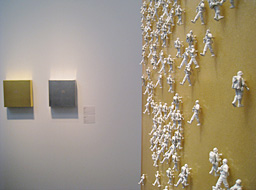 |
|
 |
| Takashi Murakami's Mr. DOB (1996), left, and Makoto Aida's A Picture of an Air Raid on New York City (War Picture Returns) (1996), right. |
|
Takashi Murakami's Polyrhythm (1990), foreground. |
|
|
The extent of art collector Ryutaro Takahashi's achievement becomes clear with a number of comparisons. Takahashifs holdings of contemporary Japanese art -- most of it made over the last fifteen years -- number somewhere over 1,500 pieces. The entire collection of the Museum of Contemporary Art, Tokyo, which covers a period four times as long (postwar till the present), is not three times as big, with just 4,000 works. The Museum of Contemporary Art, Los Angeles, incidentally, has 5,000 pieces, from 1940 till the present.
Of course, a collection is not all about size. Takahashi has major works by just about every major artist working in Japan today. He says, for example, that he has about 50 works (excluding prints) by Yayoi Kusama, about five paintings by Takashi Murakami and about ten paintings by Yoshitomo Nara. Needless to say, few museums anywhere in the world have as many works by any one of these artists, let alone all of them, and Takahashi's lead increases the younger the artists get. Think of a major solo show devoted to an artist under 45 years of age at any museum in Japan recently -- Akira Yamaguchi, Makoto Aida, or Tsuyoshi Ozawa, for example -- and Takahashi is bound to have lent one or more of the star exhibits. Artists in their thirties, such as Motohiko Odani, Zon Ito, Mika Kato, Kohei Nawa? Takahashi has several works by each. The museums? Forget about it.
There are reasons for Takahashi's standout success: he has a long-held affection for avant-garde art, and during the time he has been snapping up artworks most of Japan's museums have had their budgets cut so drastically that they simply can't keep up. Still, more interesting than the astounding mechanics of Takahashi's collection is what it tells us about Japan's art over the last decade and a half.
Welcome to "neoteny japan: Contemporary Artists after 1990s from Takahashi Collection." The exhibition, underway at Ueno Royal Museum until July 15, consists of about 80 works from Takahashi's collection, and it gives Tokyo residents their best chance yet to get an overall perspective on the fruits of his labor.
There are literally dozens of standouts. Makoto Aida's A Picture of an Air Raid on New York City (War Picture Returns) (1996) is already a contemporary classic. Choosing to depict Zero fighter planes bombing New York, and then doing it on the traditional six folding screens, captures all the confused frustration of a country that in many ways is still not sure how to assert its pride, traditions and power with regard to the United States.
The chance to behold Yayoi Deki's fantastically colorful paintings and sculptures is as pleasant as it is rare. Takashi Murakami's Polyrhythm works from around 1990, using plastic toy soldiers, are another series that is rarely seen -- despite their being among the few works in his oeuvre that are overtly political.
Ryutaro Takahashi uses the word "neoteny" to describe this period of Japanese art -- and in Murakami's use of toy soldiers, Deki's seemingly childlike paintings and Aida's adolescent raining of destruction on a faraway "enemy," it is possible to see where neoteny (the retention of childhood characteristics in the adult) plays a part. But the same can be said of almost any art, simply because it more often than not involves a child-like process of reinventing or reimagining the world. It's the quality of the message that the reinvention conveys that's important, and the messages in Takahashi's collection are as compelling as they are varied.
|